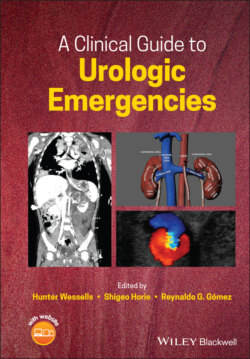Читать книгу A Clinical Guide to Urologic Emergencies - Группа авторов - Страница 29
Renal Insufficiency
ОглавлениеThe lack of long‐term follow‐up after renal trauma makes it difficult to determine the true rates of renal insufficiency after trauma. One study evaluating pediatric blunt renal trauma patients managed conservatively found that the decline in percentage of renal function of the injured renal unit correlated to the severity of renal injury, with 44.7 ± 8.4% residual function for grade II–III injuries, 41.8 ± 9.2% residual function for grade IV injury, and 29.5 ± 7.9% residual function for grade V injuries [104]. Notably, all patients had normal serum creatinine at follow‐up. This group re‐assessed renal function for a subset of these patients at one year post‐injury, finding that renal function remained stable over this time period [105]. These results are supported by another study of 67 renal injuries (36% blunt trauma) that underwent post‐injury dimercapto‐succinic acid renal scan and found that the mean decrease in renal function corresponded to injury grade (p < 0.005 in multivariate analysis), with a mean decrease in renal function of 15% for grade III, 30% for grade IV, and 65% for grade V injuries [106]. In multivariate analysis, there was no difference in the decrease in renal function between blunt and penetrating renal injury or in those injuries that were managed operatively versus conservatively.
A study evaluating 52 patients who underwent renal reconstruction after renal trauma found that renal function on the reconstructed side had a mean 39.3% preservation of function, with 81% of patients having more than one‐third function of the injured kidney based on radionucleotide scintigraphy [107].
Two studies evaluated the rates of chronic kidney disease after renal trauma. One compared trauma patients with and without renal injuries, finding that 230 patients without renal injury had an incidence of acute kidney injury of 17.4% compared to 11.4% in the patients with renal injury [108]. Another multi‐institutional study evaluating grade IV and V renal injuries (49% blunt trauma) found that 6/89 patients developed chronic kidney disease (CKD) (serum creatinine range 2.0–15.6 mg/dl), and of these 6 patients, 3/5 with long‐term follow‐up developed progressive and permanent renal failure requiring dialysis [80].
